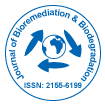Research Article
Biodegradation of Hexachlorocyclohexane (HCH) Isomers by White Rot Fungus, Pleurotus florida
| Soudamini Mohapatra1* and Meera Pandey2 | |
| 1Pesticide Residue Laboratory, Indian Institute of Horticultural Research, Hessaraghatta Lake, India | |
| 2Mushroom Culture Laboratory, Indian Institute of Horticultural Research, Hessaraghatta Lake, India | |
| Corresponding Author : | Soudamini Mohapatra Pesticide Residue Laboratory Indian Institute of Horticultural Research Hessaraghatta Lake, Bangalore 560089,India Tel/Fax: 91 80 28446649 E-mail: Soudamini_mohapatra@rediffmail.com |
| Received December 23, 2014; Accepted February 24, 2015; Published February 27, 2015 | |
| Citation: Mohapatra S, Pandey M (2015) Biodegradation of Hexachlorocyclohexane (HCH) Isomers by White Rot Fungus, Pleurotus florida. J Bioremed Biodeg 6:280. doi:10.4172/2155-6199.1000280 | |
| Copyright: © 2015 Mohapatra S, et al. This is an open-a ccess article distributed under the terms of the Creative Commons Attribution License, which permits unrestricted use, distribution, and reproduction in any medium, provided the original author and source are credited. | |
Related article at  |
|
Abstract
Hexachlorocyclohexane (HCH) isomers are reported to persist in the environment long after their usage is discontinued. Pleurotus florida, a white rot fungus, was found to degrade not only γ-HCH but also its more persistent isomers individually as well as a mixture in a Raper’s complete medium. Within 30 days γ-HCH degraded completely, whereas other 3 isomers degraded 92-99%. The degradation rate was γ-HCH>β-HCH>α- and δ-HCH. The mycelium biomass was free from γ-HCH residues but accumulated about 3% residues of other 3 isomers. Presence of intermediate metabolites was not detected indicating complete mineralization of HCH isomers. Ability of P. florida to degrade HCH isomers was further studied in soil by amendment with spent mushroom substrate (SMS). SMS addition could marginally increase degradation of α-, β- and δ-HCH, but significantly increased degradation of γ-HCH. When the study was repeated similar trend was observed. The half-life of degradation of γ-HCH was 439-570 days in un-amended soil while 37-42 days in SMS amended soil. For other 3 stable isomers the half-life was reduced from 686-828 to 88-125 days by SMS amendments. These results indicate that SMS from P. florida cultivation can be utilized for bioremediation of HCH contaminated site.
